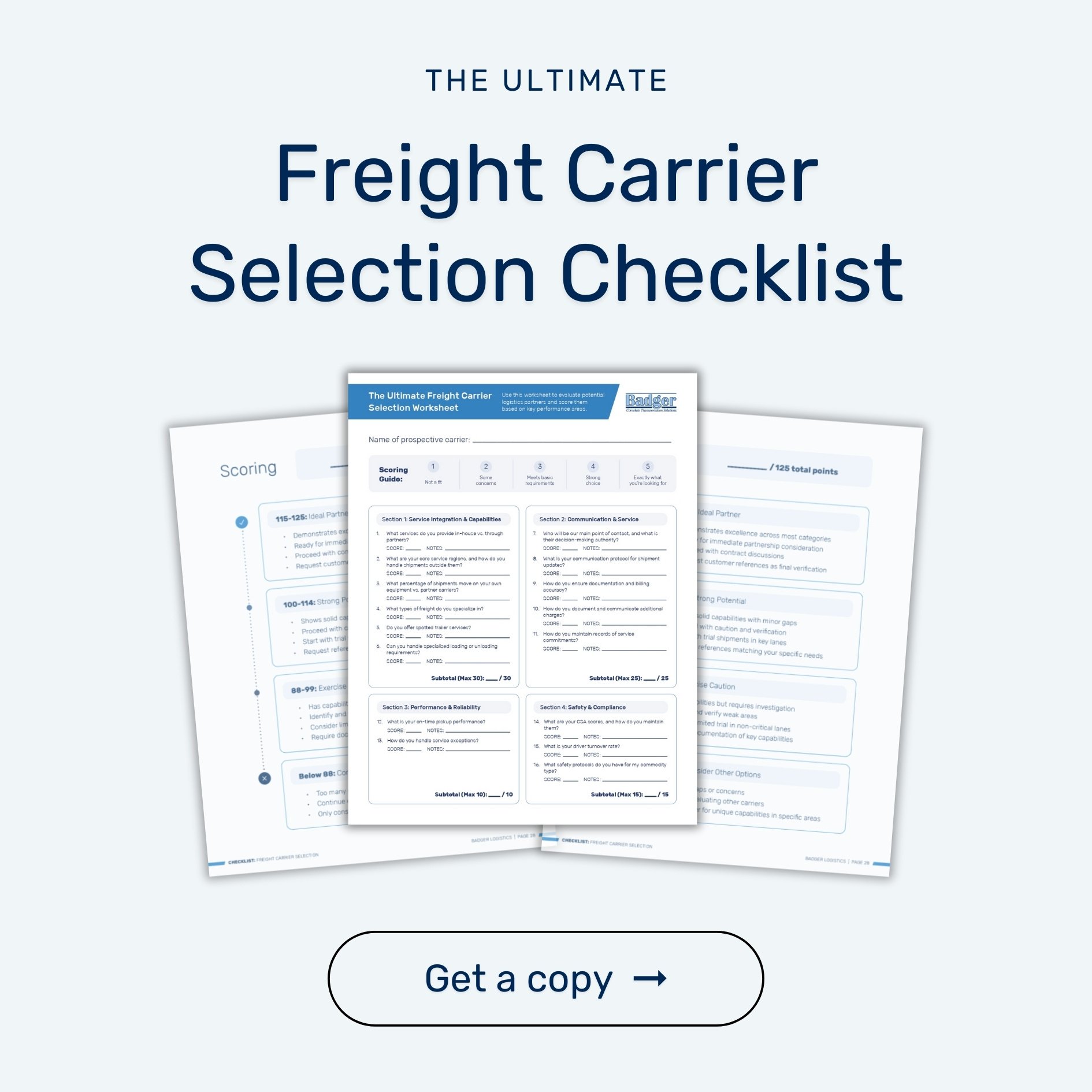In my 15+ years working with manufacturers across Wisconsin and the broader Midwest, I've seen firsthand how drop trailer service can transform a production facility's shipping operations. When implemented correctly, it eliminates waiting time, maximizes dock efficiency, and creates a buffer that keeps production flowing smoothly despite market fluctuations.
But setting up an effective drop trailer program isn't as simple as calling a carrier and asking them to leave some trailers at your facility. It requires careful planning, clear communication, and ongoing management to deliver real value.
Let me walk you through how to set up a drop trailer program that actually works for your manufacturing operation.
Initial assessment and planning
Before you pick up the phone to call potential carriers, you need to do some homework. I've seen too many manufacturers rush into drop trailer arrangements only to find they've created more problems than solutions.
Evaluate your actual volume requirements
The most critical factor in any successful drop trailer program is consistent volume. Before approaching carriers, take a hard look at your shipping patterns:
|
In my experience, manufacturers shipping at least 5-10 loads weekly on consistent lanes are the best candidates for drop trailer programs. Below that threshold, you might struggle to find carriers willing to dedicate equipment to your facility without significant cost premiums.
Identify space requirements
One of the most commonly overlooked aspects of drop trailer programs is space planning.
Your yard has to accommodate:
|
I've visited manufacturing facilities where trailers were spotted in locations that created bottlenecks for other operations or violated safety protocols. Before implementation, walk your facility with your operations team to identify optimal positioning that balances accessibility with security and operational flow.
Establish your loading schedules
When will you typically load trailers? This information is crucial for carrier planning. If you operate multiple shifts, determine which shifts will be responsible for loading. Map out your typical production completion times to identify the optimal loading windows. This schedule helps you communicate expected turnaround times to your carrier partner and ensures they can plan driver dispatching efficiently.
Selecting a carrier
Not all carriers are created equal when it comes to drop trailer service. The right partner makes all the difference in program success.
In my years at Badger Logistics, I've found that asset-based carriers like our Badger Express division are typically better positioned to offer reliable drop trailer service. Why? Because they control their own equipment and can make decisions about equipment allocation without third-party complications.
Brokers may promise drop trailer service, but they're often limited in their ability to consistently provide it since they're dependent on their carrier network's equipment availability. When capacity tightens, those promises can quickly evaporate.
Asset-based carriers have skin in the game — they own the trailers they're spotting at your facility. This creates alignment in making sure those assets are efficiently utilized.
Consider geographic proximity, too
The economics of drop trailer service are heavily influenced by geographic proximity. Carriers with terminals near your facility can more efficiently rotate equipment, respond to surge needs, and troubleshoot issues that arise.
In my experience, ideal partners are located within 50-100 miles of your manufacturing facility. For Wisconsin manufacturers, this regional approach often works better than national programs that may look good on paper but lack the local flexibility needed for success.
Review equipment specs
Before finalizing any partnership, ensure your potential carrier partners have:
|
For food-grade manufacturing especially, clean equipment history is non-negotiable. At Badger Express, we maintain detailed cleaning records for our food-grade trailers and can provide that documentation to manufacturers who require it.
Implementation steps
Once you've selected your carrier partner, it's time to implement your program. Clear documentation and communication protocols are essential.
1. Negotiate clear termsThe foundation of any successful drop trailer program is a clear written agreement. Your agreement should cover:
I've seen too many drop trailer programs fall apart because of misunderstandings about these basic terms. Get everything in writing, and make sure both operations teams (yours and the carrier's) understand the agreement terms. |
2. Set up a solid communication processEfficient notification systems are critical for drop trailer success. Implement processes for:
The best programs use technology to streamline these communications. At Badger, we've integrated with several manufacturers' systems to automate notifications, removing the human delay factor that can lead to equipment utilization issues. |
3. Establish documentation proceduresCreate processes for your team to:
These documentation procedures protect both parties and create an audit trail that can help identify and resolve any issues that arise. |
A few optimization strategies
Once your drop trailer program is running, look for opportunities to optimize it further.
The best way to do this is to create a production schedule to maximize trailer utilization. This might include:
|
For our local Wisconsin customers, we offer additional flexibility. Depending on what the customer wants, if they have daily transfers, I get operations involved. And then we have the flexibility to preload the trailers so there's no wait for a driver. He hooks and he leaves.
This preloading capability can dramatically improve efficiency for both parties but requires coordinated planning to execute successfully.
You can also work with your carrier to adjust the pool size based on:
- Seasonal production fluctuations
- Planned maintenance shutdowns
- Special product launches or promotions
The most sophisticated programs I've implemented include formal quarterly reviews where we adjust pool size based on forecasted production changes, preventing both equipment shortages and underutilization.
Final thoughts and next steps
At Badger Logistics, we've built our drop trailer service specifically for Wisconsin and Midwest manufacturers, with an understanding of the unique challenges they face—from seasonal road restrictions to specific industry requirements.
By following these steps and working closely with a regional carrier that understands your manufacturing needs, you can implement an efficient drop trailer program that enhances your operational flexibility and reduces loading/unloading bottlenecks.
Have questions about implementing drop trailer service at your facility? I'm always happy to provide a no-obligation assessment of whether this approach makes sense for your specific operation.
Need a Wisconsin 3PL partner? Let's talk
At Badger Logistics, we combine asset-based trucking with extensive brokerage capabilities, warehousing, and maintenance services to provide integrated logistics solutions for Wisconsin shippers. This guide reflects not just my personal experience but the collective wisdom of our team, which brings over a century of combined Wisconsin logistics experience to every shipment we handle.

While freight transportation will always involve challenges, the right approach and partnerships can transform logistics from a constant struggle into a sustainable competitive advantage. I hope this guide helps you navigate Wisconsin's unique shipping environment more effectively.
For specific questions or to discuss your particular freight challenges or to get a competitive quote, feel free to reach out directly or submit the quote request form below. We'll be in touch within one business day.
Asset-based trucking:
- Local, regional, and long-haul FTL services with 53' food-grade dry van trailers (plate trailers offering up to 101.5” inside width, under 10 years old)
- Safe, compliant driver pool with late-model equipment
- Drop trailer services
- Strategically located in southeastern Wisconsin
- McLeod TMS integrated with Samsara for in-cab communication and tracking
- Superior safety scores and dedicated customer service reps ensure smooth freight movement from pickup to delivery
Full-service freight brokerage:
- 12,000+ annual shipments for 500+ customers
- Access to 15,000+ partner carriers
- Full truckload and partial shipments
- Dry van, reefer, flatbed, and intermodal options
- Door-to-door tracking
- Gold Book rated credit score
Integrated warehousing:
- Secure, strategic storage in southeastern Wisconsin
- Food-grade storage (FDA and DATCAP)
- 27 dock doors for efficient access
- 24/7 security monitoring and fire protection
- Flexible scheduling and deliveries
- Consolidation and order fulfillment services
-
Cross docking, kitting, and assembly





